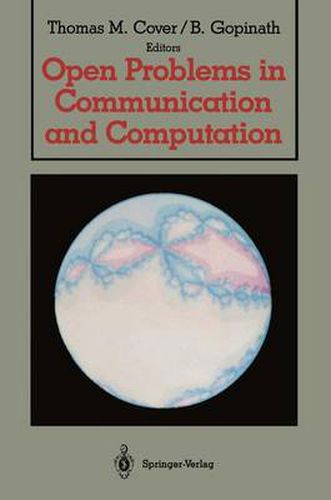Readings Newsletter
Become a Readings Member to make your shopping experience even easier.
Sign in or sign up for free!
You’re not far away from qualifying for FREE standard shipping within Australia
You’ve qualified for FREE standard shipping within Australia
The cart is loading…






This title is printed to order. This book may have been self-published. If so, we cannot guarantee the quality of the content. In the main most books will have gone through the editing process however some may not. We therefore suggest that you be aware of this before ordering this book. If in doubt check either the author or publisher’s details as we are unable to accept any returns unless they are faulty. Please contact us if you have any questions.
Thomas M. Cover and B. Gopinatb The papers in this volume are the contributions to a special workshop on problems in communication and computation conducted in the summers of 1984 and 1985 in Morristown, New Jersey, and the summer of 1986 in Palo Alto. California. The structure of this workshop was unique: no recent results. no surveys. Instead. we asked for outstanding open prob~ lems in the field. There are many famous open problems, including the question P = NP?, the simplex conjecture in communication theory, the capacity region of the broadcast channel. and the two*helper problem in information theory. Beyond these well-defined problems are certain grand research goals. What is the general theory of information flow in stochastic networks? What is a comprehensive theory of computational complexity? What about a unification of algorithmic complexity and computational complex ity? Is there a notion of energy-free computation? And if so, where do information theory, communication theory, computer science, and physics meet at the atomic level? Is there a duality between computation and communication? Finally. what is the ultimate impact of algorithmic com plexity on probability theory? And what is its relationship to information theory? The idea was to present problems on the first day. try to solve them on the second day, and present the solutions on the third day. In actual fact, only one problem was solved during the meeting – El Gamal’s prob* lem on noisy communication over a common line.
$9.00 standard shipping within Australia
FREE standard shipping within Australia for orders over $100.00
Express & International shipping calculated at checkout
This title is printed to order. This book may have been self-published. If so, we cannot guarantee the quality of the content. In the main most books will have gone through the editing process however some may not. We therefore suggest that you be aware of this before ordering this book. If in doubt check either the author or publisher’s details as we are unable to accept any returns unless they are faulty. Please contact us if you have any questions.
Thomas M. Cover and B. Gopinatb The papers in this volume are the contributions to a special workshop on problems in communication and computation conducted in the summers of 1984 and 1985 in Morristown, New Jersey, and the summer of 1986 in Palo Alto. California. The structure of this workshop was unique: no recent results. no surveys. Instead. we asked for outstanding open prob~ lems in the field. There are many famous open problems, including the question P = NP?, the simplex conjecture in communication theory, the capacity region of the broadcast channel. and the two*helper problem in information theory. Beyond these well-defined problems are certain grand research goals. What is the general theory of information flow in stochastic networks? What is a comprehensive theory of computational complexity? What about a unification of algorithmic complexity and computational complex ity? Is there a notion of energy-free computation? And if so, where do information theory, communication theory, computer science, and physics meet at the atomic level? Is there a duality between computation and communication? Finally. what is the ultimate impact of algorithmic com plexity on probability theory? And what is its relationship to information theory? The idea was to present problems on the first day. try to solve them on the second day, and present the solutions on the third day. In actual fact, only one problem was solved during the meeting – El Gamal’s prob* lem on noisy communication over a common line.